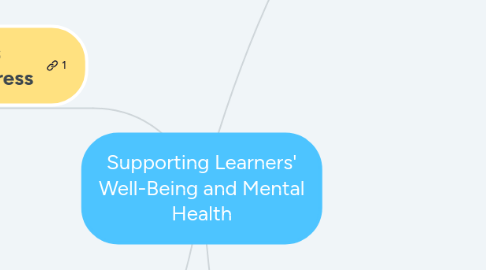
1. Identify Possible Reasons Students feel Anxiety/Stress
1.1. Tests/Assignments/Presentations
1.2. Scheduling & Time Management
1.3. Social Pressure/Friends/Online Demands
1.4. Family/Home Struggles
1.5. Personal Identity/Questions
2. Facilitate Student Leadership
2.1. Students lead discussions on various 'mental health' topics
2.2. Students create Mindfulness Activities directed to their peer group
2.2.1. Students lead these activities with peers and move forward with feedback
2.3. Student partnerships created to support classmates with scheduling, studying, organization
2.4. Students help teacher to design (take ownership of) the classroom blueprint
2.4.1. Change design of classroom 1/month
3. Create a Positive Classroom Environment
3.1. Physical Space
3.1.1. bright colours
3.1.2. easy to move through furniture
3.1.3. positive/encouraging quotes
3.1.4. areas for group work and quiet, individual seating areas
3.1.5. Classroom Values
3.1.5.1. Reading Nook
3.1.5.2. Faith Table
3.1.5.3. Celebration of student work
3.1.5.4. Plants
3.1.5.5. Creation/Maker Space/Access to Mindfulness Activities
3.1.6. Daily schedule posted
3.1.7. Calendar of events/due dates posted and reviewed daily
3.2. Behaviour Expectations
3.2.1. Everyone has a voice
3.2.2. We listen to the thoughts/ideas of others
3.2.3. We all have jobs/responsibilities within the classroom (this changes weekly)
3.2.4. We are respectful of our uniqueness
3.3. Teacher Role
3.3.1. Positive Reinforcement
3.3.2. Morning check-in/Mindful Activity
3.3.3. Provide extra time for tests/assignments
3.3.4. Model/Implement Mindfulness Activities
3.3.4.1. Guided Meditation
3.3.4.2. Yoga/Movement
3.3.4.3. Taking a break outside
3.3.5. Celebration of student achievement
3.3.5.1. Academic Improvements
3.3.5.2. Being kind to others
3.3.5.3. Taking initiative with a task that benefits a peer or the classroom or the school
3.3.6. Establishing Connection
3.3.6.1. Smiling and laughing
3.3.6.2. Caring and listening
3.3.6.3. One-on-one conversation with students
3.3.6.4. Sharing personal stories/experiences where appropriate
3.3.6.5. Welcoming & Approachable
4. Communication & Collaboration
4.1. Parents
4.1.1. Ongoing and consistent communication
4.1.2. Offer resources when needed
4.1.3. Contact parents with concerns
4.1.3.1. Contact parents to praise child
4.2. Community Members
4.2.1. Invite police, authors, artists into the classroom to enhance learning
4.2.2. Invite leaders of mental health organizations to lead workshops to both staff and students
4.3. Resources
4.3.1. Guided Meditations
4.3.1.1. books
4.3.1.2. music
4.3.1.3. apps (e.g. CALM)
4.3.2. Create a list of resources to offer students and parents (e.g. Kids Help Phone, Tangerine)

